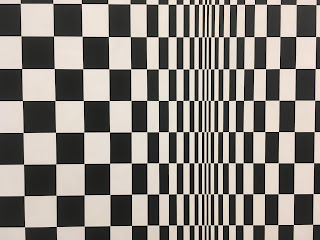A 'photo-blog' this time, following my visit to the Bridget Riley retrospective exhibition, running at the Hayward Gallery in London's Southbank Centre until 26 January 2020.
Riley's work was among the very first abstract art I loved. While I had no idea what 'op art' was at the time, I always loved 'optical illusion' puzzles and curiosities as a kid. No surprise, then, that I've always been mesmerised by Riley's manipulation of colours (or the lack of them) and shapes (or the spaces between them) - and the grand scale on which she achieves it.
Here, I'm going to take you on a short tour of some of my highlights of the show. Nothing - not even a copy of the handsome catalogue - can really replace going to see the pieces in the 'flesh'. You have to imagine many of them filling your field of vision, or being able to get close enough to see the subtle variations in the lines and patterns, or marvel at the brushwork's precision in the service of such restrictive, rigorous designs.
The dazzling black and white images - surely her most recognisable work to this day - have this almost frightening ability to make you see false shapes, or a third dimension that isn't there, especially as you move forward and back or side to side in front of the painting. In some cases, I had that weird sensation not unlike when the eyes of a portrait seem to follow you around the room - but here it's a void that responds to your actions. Then I think the art touches on something almost terrifying, apocalyptic.
As a comprehensive survey, the exhibition covers some aspects of her career that I hadn't previously been aware of - for example, her admiration for Seurat. While the art she went on to produce doesn't resemble Seurat's, she was influenced by his approach - and the curation does its best to tease this out:
We also get to see some of her very early pieces...
I was fascinated to see signs in the 'pre-abstract' work of possible later preoccupations: the 'rejections' of the face, each hidden, altogether missing, or fading, somehow incomplete; shapes and their shadows; geometric lines.
The show also took in some less familiar media - for example, some of her works on perspex (where the images feel almost like trademarks or esoteric logos of some kind), and her only 3-D large-scale installation, where you can walk inside and be surrounded by a Riley painting - notwithstanding the short queue, very few people stayed in there for long!
But the more familiar I am with an artist and the more I go to see their work, the more easily I can let my mind wander onto other aspects ... in particular, the 'hang'. I was struck by how sometimes an exhibition can find its perfect gallery, and that has definitely happened here. My final sequence of snaps is meant to give you an idea of just what it was like to move around in the space and experience these pictures: surely the white and grey austere lines of the Hayward were just waiting for Riley to come along.
(Brief warning - as this is a little like street photography with a roof, I'm anxious that no-one in the photos can be readily identified. As a result, I experimented with the editing functions on my laptop and, in an unexpected turn of events, managed to completely remove two peoples' heads. I've actually left these individuals in the pictures as a kind of tribute to Riley's erasure of faces. Please rest assured that I didn't actually decapitate anyone in the gallery to achieve my aesthetic aims...)
I hope you've enjoyed the photographs. You can find details of the exhibition here on the Southbank Centre website.




























No comments:
Post a Comment